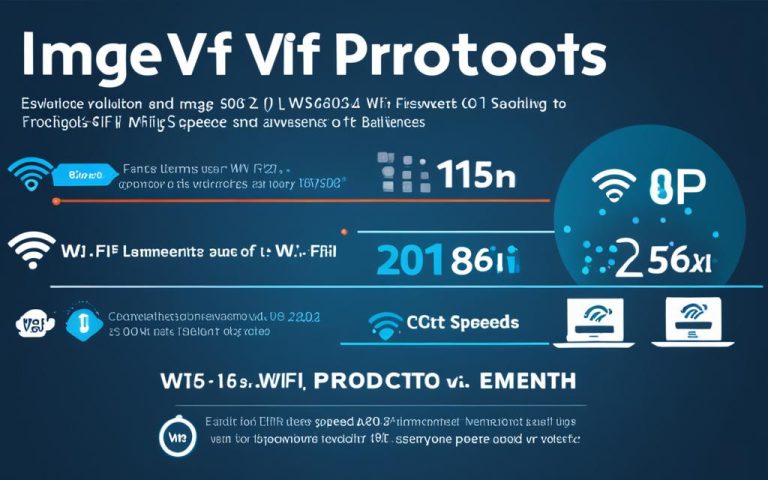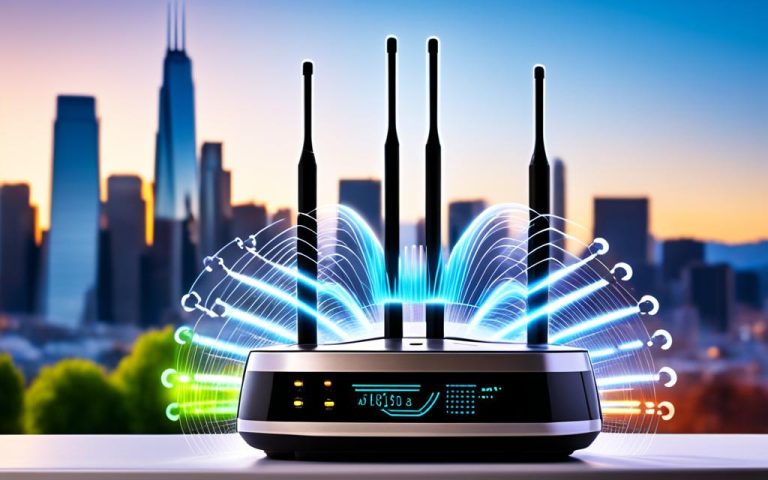As technology continues to advance, our reliance on Wi-Fi networks has exponentially grown. Whether it’s for work, entertainment, or communication, a stable and reliable Wi-Fi connection is essential. However, there are instances where the coverage and performance of Wi-Fi networks may fall short, leaving us frustrated and disconnected.
That’s where beamforming technology comes into play. Beamforming is a revolutionary technique that allows Wi-Fi signals to be steered in a specific direction, optimizing their reach and improving WLAN coverage. By intelligently focusing the signal towards the intended recipient, beamforming effectively reduces interference and enhances the overall Wi-Fi experience.
Beamforming technology has been present in Wi-Fi networks since the introduction of Wi-Fi 4. Leveraging the power of MIMO (multiple input multiple output) technology, beamforming enables the transmission of multiple overlapping signals. This results in improved coverage, increased data rates, and enhanced performance.
With the advent of Wi-Fi 6 (802.11ax), beamforming technology has taken a major leap forward. Wi-Fi 6 introduces vendor-neutral interoperability for beamforming, making it compatible across different devices and routers. Additionally, Wi-Fi 6 supports multi-user MIMO, enabling efficient communication between multiple devices and the router simultaneously.
Looking ahead, Wi-Fi 7 (802.11be) is set to revolutionize the way we experience Wi-Fi networks. Coordinated beamforming in Wi-Fi 7 will further enhance network capacity and efficiency, unleashing the full potential of modern multi-antenna access points.
Beamforming technology is a game-changer for Wi-Fi connectivity. It improves coverage, reduces interference, and ensures a seamless experience for users. However, it’s important to consider the limitations of beamforming, such as its diminishing benefits at longer distances. By understanding the specific requirements and environment of a Wi-Fi network, beamforming can be effectively implemented to maximize its benefits.
In the following sections, we will delve deeper into the benefits and limitations of beamforming technology, the impact it has on Wi-Fi connectivity, and its evolution in conjunction with the advancements in Wi-Fi technology.
The Benefits and Limitations of Beamforming Technology
Beamforming technology offers several benefits for Wi-Fi networks. It allows for targeted Wi-Fi signals, improving coverage and reducing interference. With the support of multi-user MIMO, beamforming enables efficient communication between multiple devices and the router simultaneously. Wi-Fi 6 has also increased the number of supported antennas, enhancing data rates and extending the range for specific clients.
However, beamforming has limitations. Its benefits diminish the farther away a receiver is from a transmitter. While beamforming can significantly improve performance at close proximity, its effectiveness decreases as the distance increases.
Implementing beamforming in Wi-Fi networks requires careful consideration of these limitations. The advantages of beamforming should be weighed against the specific requirements and challenges of the network environment.
Overall, the benefits of beamforming technology, such as improved coverage, reduced interference, and efficient multi-device communication, make it a valuable tool for enhancing Wi-Fi networks. However, the limitations of beamforming necessitate strategic implementation to maximize its effectiveness.
Benefits of Beamforming:
- Improved coverage and reduced interference
- Efficient communication between multiple devices and the router
- Enhanced data rates and extended range for specific clients
Limitations of Beamforming:
- Diminished benefits as the receiver moves farther from the transmitter
The Impact of Beamforming on Wi-Fi Connectivity
The impact of beamforming on Wi-Fi connectivity can vary based on several factors. While beamforming technology has the potential to improve coverage and performance in medium ranges, its effectiveness may be limited at shorter or longer distances.
The success of beamforming is influenced by the characteristics of the radio environment, the sophistication of the antenna array, and the relative motion between devices. These factors play a crucial role in determining the overall impact of beamforming on Wi-Fi connectivity.
When used in combination with other techniques, such as multi-user MIMO, beamforming can result in a modest improvement in the performance of Wi-Fi networks.
It is important to consider the specific requirements and environment of the network when assessing the impact of beamforming on Wi-Fi connectivity.
By harnessing the advantages of beamforming technology, Wi-Fi networks can benefit from enhanced coverage and improved signal quality, leading to better user experiences. Properly implementing beamforming can optimize Wi-Fi connectivity within the medium range, offering a reliable and efficient network connection.
The Evolution of Beamforming in Wi-Fi Technology
Beamforming technology has continued to progress alongside advancements in Wi-Fi technology, enabling more efficient and reliable wireless network connections. Since its introduction in Wi-Fi 4, beamforming has undergone significant improvements in subsequent Wi-Fi generations, including Wi-Fi 5 and Wi-Fi 6.
Wi-Fi 5, also known as 802.11ac, brought about a crucial development in beamforming by introducing vendor-neutral interoperability for beamforming techniques. This means that different receivers can now effectively work with different routers, regardless of the manufacturer. With this interoperability, users have greater flexibility in choosing Wi-Fi devices without worrying about compatibility issues related to beamforming technology.
However, it was in Wi-Fi 6 (802.11ax) where beamforming truly evolved, revolutionizing the capabilities and performance of Wi-Fi networks. Wi-Fi 6 introduced enhancements such as increased supported antennas, resulting in better data rates and extended range. This advancement enables Wi-Fi 6 networks to support more devices simultaneously while providing improved coverage and reduced latency.
Looking ahead, beamforming is set to play a significant role in the upcoming Wi-Fi 7 (802.11be). Wi-Fi 7 will further exploit the potential of coordinated beamforming, leveraging the capabilities of modern multi-antenna access points. This coordinated beamforming will lead to substantial enhancements in throughput and latency, pushing the boundaries of Wi-Fi network performance.
The Evolution of Beamforming in Wi-Fi Generations:
| Wi-Fi Generation | Beamforming Advancements |
|---|---|
| Wi-Fi 4 (802.11n) | Introduction of beamforming technology |
| Wi-Fi 5 (802.11ac) | Vendor-neutral interoperability for beamforming techniques |
| Wi-Fi 6 (802.11ax) | Increased supported antennas for improved data rates and extended range |
| Wi-Fi 7 (802.11be) (Upcoming) | Coordinated beamforming for substantial enhancements in throughput and latency |
As Wi-Fi technology continues to advance, beamforming will remain a key component in driving the performance and capabilities of wireless networks. The evolution of beamforming has provided significant benefits, enabling greater flexibility, improved coverage, and enhanced overall Wi-Fi connectivity.

Conclusion
Beamforming technology is a valuable tool for enhancing WLAN coverage and Wi-Fi connectivity. By utilizing multiple overlapping signals, beamforming improves coverage and reduces interference, resulting in a more reliable and efficient Wi-Fi network.
One of the key benefits of beamforming is its ability to enable efficient communication between multiple devices and the router simultaneously, thanks to support for multi-user MIMO. This is particularly valuable in environments with a high number of connected devices.
However, it is important to note that the effectiveness of beamforming depends on various factors, including distance, radio environment, and antenna array sophistication. While it can significantly enhance Wi-Fi performance in medium ranges, its benefits may diminish at shorter or longer distances.
With advancements in Wi-Fi technology, such as Wi-Fi 6 and the upcoming Wi-Fi 7, beamforming techniques have evolved to offer even greater improvements in coverage and performance. Wi-Fi 7 will leverage coordinated beamforming to further enhance network capacity and efficiency, resulting in substantial throughput and latency enhancements.
To maximize the benefits of beamforming, it is crucial to consider the specific requirements and environment of the Wi-Fi network. By understanding these factors and implementing beamforming technology appropriately, businesses and individuals can enjoy optimized WLAN coverage and improved Wi-Fi connectivity.
FAQ
What is beamforming technology?
Beamforming is a technology that utilizes MIMO (multiple input multiple output) technology to send out multiple overlapping signals, improving the coverage and performance of Wi-Fi networks.
Which generation of Wi-Fi introduced beamforming?
Beamforming has been present in Wi-Fi since the introduction of Wi-Fi 4.
What are the benefits of beamforming technology?
Beamforming technology offers several benefits such as improved coverage, reduced interference, and efficient communication between multiple devices.
Does beamforming have any limitations?
Yes, the benefits of beamforming diminish the farther away a receiver is from a transmitter. It is important to consider these limitations when implementing beamforming in Wi-Fi networks.
What factors influence the impact of beamforming on Wi-Fi connectivity?
The effectiveness of beamforming is influenced by the radio environment, the sophistication of the antenna array, and the relative motion between devices.



















